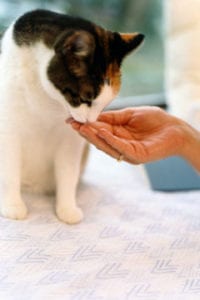
Cats are unique and sometimes mysterious creatures. They behave in the strangest ways sometimes, and considering their independent nature, many cat owners are left asking themselves, “How do I know if my cat loves me?” Here at Thornhill Pet Hospital, we know cats, and we’re very familiar with their behaviors. Check out these five signs of an affectionate cat and see which ones apply to YOUR feline friend.
Head Butting
Head butting may not sound like an affectionate behavior, but in the feline kingdom, it actually is. Also known as head bunting, head butting is a sign of affection because when your cat rubs his head against something, he releases facial pheromones. Feline facial pheromones are used to mark surfaces as safe, so the next time your cat head butts you, he’s telling you he trusts you. Give him a nice scratch on the head to acknowledge the gesture. It’ll probably make him like you even more!
Kneading
Many cat owners don’t know the name of this behavior and would describe it as the “slow motion lifting of the paws.” Some cats knead couches and blankets. Some also knead their owners’ laps, stomachs, and even their hair as they’re trying to sleep! Kneading is a behavior that begins at kittenhood, when kittens knead against their mothers to stimulate milk production, resulting in a feeling of contentment. When adult cats knead, experts believe it’s associated with that same kind of feeling, so the next time you feel those little paws pressing against you, it’s just your cat letting you know she loves you.
Purring
Cats can purr for a variety of reasons, with vibrations ranging from 20-140 Hz. One of the great things about a cat’s purr is that not only can it be a sign of affection; it can also benefit your health. Purring has a type of “healing power” and can lower your stress levels while lowering your blood pressure. So never miss an opportunity to give your cat a pet or scratch on the head or under his chin to get him purring!
Back Rolling
When your cat rolls on her back, exposing her belly, it often means she’s trying to get your attention (usually for food). Since this is a vulnerable position for an animal to be in, a cat puts itself in this position ONLY around someone it trusts. In your cat’s case, this “someone” is you! The “tummy up” position is a sign that your cat loves you and feels safe in your company.
Vertical Tail
Just as the motions of a dog’s tail can signify certain emotions, the motions of a cat’s tail can signify emotions, too, ranging from contentment to fear. When you see your cat’s tail in a straight, vertical position, it means she’s in a good mood and happy to see you. Let your feline friend you’re happy to see her, too!
Have questions about these signs or need to book an appointment for your feline friend at Thornhill Pet Hospital? Give us a call at (510) 339-2041.
